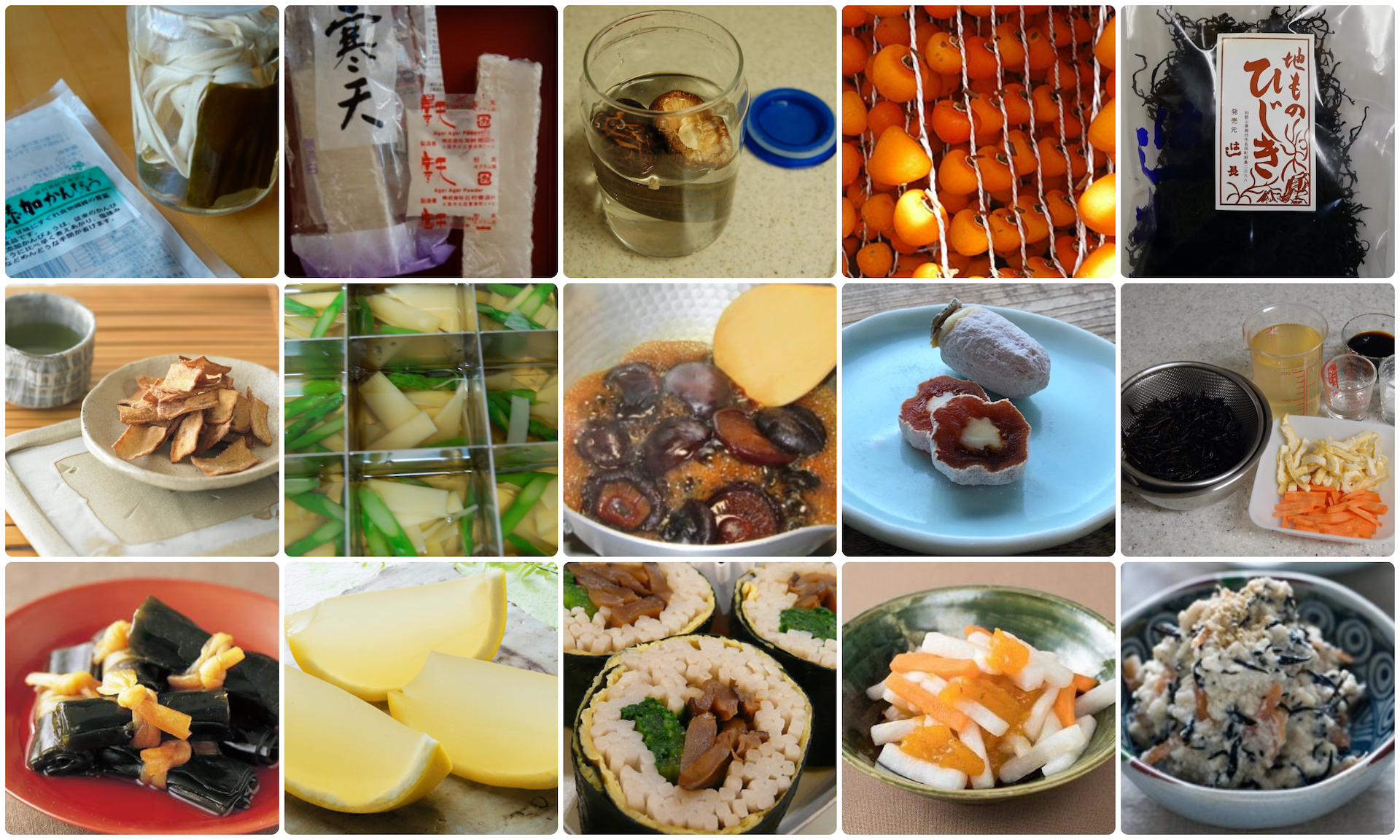
In the photo above, there are five vertical columns, from left to right: KAMPYO (soaking in water with kombu; deep-fried to make chips; used as an edible tie for kombu rolls); KANTEN (sticks and powdered form, made into a savory bamboo shoot and asparagus aspic, lemon aspic); DRIED SHIITAKE (soaking with in water with kombu, soy-simmering, rolled into a noodle “sushi” with blanched spinach); PERSIMMONS (strung to air-dry, dried persimmons stuffed with cream cheese, dried persimmons and turnips in sweet-and-sour sauce); HIJIKI (dried in package, ingredients for making simmered dish with carrots and fried tofu; simmered hijiki and carrots tossed in tofu sauce).
乾物・かんぶつ・KAMBUTSU
“DRIED THINGS”
The traditional Japanese pantry is filled with wrinkled, weathered-looking things collectively known as kambutsu (literally, “dried things”). Shriveled and appearing a bit forlorn, these modest-looking marvels can deliver a powerful umami punch when properly prepared.
Intensely flavorful and nutrient-dense, kambutsu are usually humbly priced and can be kept without refrigeration for extended periods of time (weeks, months, even years).
Kambutsu can be sourced from the LAND (fields, forests, mountains) and from the SEA (oceans, rivers, streams, ponds). Most kambutsu are savory, though some (especially fruit) can be sweet.
The primary use for some kambutsu is stock-making; kombu, katsuo-bushi and niboshi (also known as iriko) are good examples.
There are also multi-tasking kambutsu where the rehydrating liquid becomes a deeply flavored and nutrient-rich stock while the softened item is enjoyed on its own, in combination with other kambutsu, and/or paired with fresh foods. Dried shiitake is a good example of a multi-tasking kambutsu.
BUT… the rehydrating liquid from several kinds of kambutsu, should NOT be consumed. Be sure to throw away the liquid produced when softening hijiki and wakamé and any produce dried with chemicals. Check the labels to be sure, especially for kampyo and shiitake.
The Well-Stocked Pantry chapter of From KANSHA, Celebrating Japan’s Vegan and Vegetarian Traditions, (Ten Speed Press, 2010), pages 128-153 focuses on kambutsu.
In WASHOKU, Recipes from the Japanese Home Kitchen (Ten Speed Press, 2005), the chapter, The Washoku Pantry (pages 10-64) catalogues a variety of kambutsu in addition to other shelf-stable items. The Vegetables chapter begins with four dishes featuring kambutsu (pages 186-190). The Desserts chapter includes a recipe for kanten (agar-agar) page 308.

Japan Eats PODCAST
I enjoyed chatting with Akiko Kayayama, host of Japan Eats,Heritage Radio Network. Listen to the show, Episode 273 that aired on September 26, 2022.




